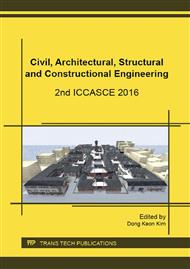[1]
P. Zhang, W. Yan, Dynamic response analysis of underground rock tunnel under earthquake load, 2nd International Conference on Structures and Building Materials, 446-449 (2012) 2089-(2092).
DOI: 10.4028/scientific5/amr.446-449.2089
Google Scholar
[2]
Z. Z. Wang, Z. Zhang, Seismic damage classification and risk assessment of mountain tunnels with a validation for the 2008 Wenchuan earthquake, Int. J. Soil Dynam. Earthq. Eng. 45(2) (2012) 45-55.
DOI: 10.1016/j.soildyn.2012.11.002
Google Scholar
[3]
F. S. Wang, H. J. Zhang, W. H. Zhu, Damage information fusion model to military engineering based on intellectualized structure, 2010 International Conference on Computing, Control and Industrial Engineering, 333-336.
DOI: 10.1109/ccie.2010.91
Google Scholar
[4]
F. B. Yang, X. X. Wang, Conflict evidence combination method on D-S evidence theory, Beijing, National Defense Industry Press, (2010).
Google Scholar
[5]
H. Zhang, Y. J. Wang, D. Y. Luo, Modified D-S evidence theory and its application in water quality assessment, Chin. J. Comput. Syst. 31(6) (2010) 1236-1239.
Google Scholar
[6]
R. Yager, On the dempster-shafer framework and new combination rules, Int. J. Inform. Sci. 41(2) (1989) 93-137.
Google Scholar
[7]
P. Smets, The combination of evidence in the transfemble belief model, IEEE T. Patt. Analys. Mach. Intell. 12(5) (1990) 447-458.
Google Scholar
[8]
K. Pan, H. Li, G. Xing, Conflict evidence synthesis method based on confidence distance, Chin. J. Comput. Eng. 39(1) (2013) 290-293.
Google Scholar
[9]
C. K. Murphy, Combining belief functions when evidence conflicts, Int. J. Decis. Support Syst. 29(1) (2000) 1-9.
Google Scholar
[10]
Y. Li, Y. G. Wang, X. M. Xu, Research on convergence and conflict treatment in evidence fusion, Chin. J. Syst. Eng. Electron. 34(6) (2012) 1113-1119.
Google Scholar
[11]
L. Zadeh, A simple view of the dempster-shafer theory of evidence and its impficafion for the rule of combination, Int. J. AI Mag. 7(1) (1986) 85-90.
Google Scholar
[12]
R. Luo, M. G. Kay, Multisensor integration and fusion in intelligent systems, IEEE Trans. SMC, 19(5) (1989) 901-931.
DOI: 10.1109/21.44007
Google Scholar
[13]
H. Luo, Y. P. Yin, X. X. Hu, et al. Method to modify evidence source based on trustworthy factors, Chin. J. Syst. Eng. Electron. 37(6) (2015) 1459-1464.
Google Scholar
[14]
H. F. Wang, X. Y. Wang, Development and problems of D-S evidential reasoning in multisensor data fusion, Chin. J. Mod. Electron. Technol. 15 (2009) 7-9.
Google Scholar
[15]
L. W. Zhang, J. S. Yuan, Power transformer fault diagnosis based on typical sample and evidence theory, Chin. J. Electr. Measure. Instrument. 50(8) (2013) 14-19.
Google Scholar
[16]
Y. Liu, X. G. Gao, G. S. Lu, et al. Multisensor target recognition based on the weighted evidence combination, Chin. J. Syst. Eng. Electron. 25(12) (2003) 1475-1477.
Google Scholar


